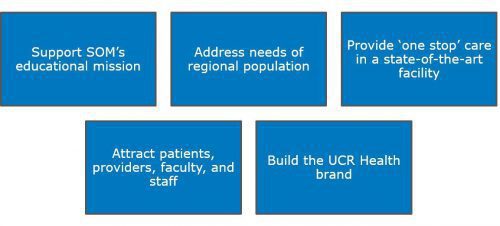Developing an Ambulatory Care Clinical Enterprise for the University of California, Riverside, School of Medicine
Client/Profile
University of California, Riverside (UCR), School of Medicine. This new school of medicine, located in a seriously underserved population of 2 million, just graduated its first class. The school is “dedicated to expanding and diversifying the physician workforce in Inland Southern California, and to developing research and health care delivery programs that will improve the care of the region’s underserved populations.” The initial focus is on primary care and specialties that are in short supply, including psychiatry and Ob/Gyn.
Challenge/Situation
To help the medical school develop a plan for its own ambulatory services clinical enterprise to meet the school’s goals. The medical school was always intended to function without an inpatient academic medical center of its own, instead making use of existing hospitals and physician practices throughout the area.
UCR SCHOOL OF MEDICINE GOALS FOR AMBULATORY SERVICES CLINICAL ENTERPRISE
Effective recruiting of clinical faculty for UCR School of Medicine requires that there be an attractive, productive location for those faculty to practice, and the school’s long-term viability requires that it have a core location for its ambulatory care education programs.
Process
Veralon worked very interactively with the School of Medicine and the University’s capital/facility planning department in developing the plan. A core project management team met every three weeks for two and a half hours, and reviewed every aspect of the analysis and recommendations. A steering committee including the dean and senior faculty met four times during the process.
Planning tasks included a wide range of interviews, both internal and external strategic business planning analyses, projected utilization and resource needs, many rounds of scenario analysis, and development of recommendations on service mix, space requirements, and project budget and financial projections.
Results
The plan, as approved by the School, provides a progressive, sustainable model of ambulatory care that will break even by year 5. The plan specifies a portfolio of clinical and ancillary services that can stand on its own, and includes staffing, space, and capital equipment requirements. We enumerated critical success factors and key milestones, as well as identifying required pre-opening activities. The client is now seeking funding to move ahead with the plan.
